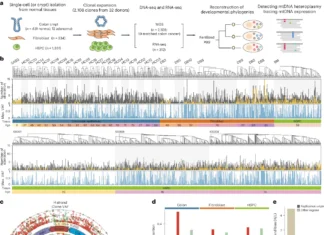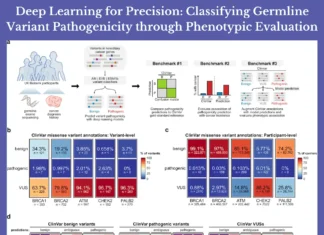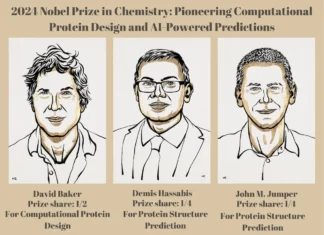Omega-3 and Omega-6 Fatty Acids: New Allies in Cancer Prevention
A groundbreaking new research from the University of Georgia unveils that omega-3 and omega-6 fatty acids may play an integral role in cancer prevention,...
The Future of Bioinformatics: Building Expertise for Data-Driven Discovery
In an era where biological data grows exponentially, bioinformatics has emerged as a vital interdisciplinary field that combines biology, computer science, mathematics, and statistics....
The Power of Foundation Models in Pathology: How Paige’s Virchow is...
Computational pathology is the evolution of cancer diagnosis into a new era, with the application of artificial intelligence to understand complex histopathology images. Generally,...
Unlock Molecular Conformations with Moltiverse Using Enhanced Sampling Molecular Dynamics Simulations
For drug development to be effective, it is essential to accurately predict the various bound-state conformations of small compounds, especially in situations where intricate...
AlphaFold3 Goes Open Source: A New Chapter in AI-Powered Protein Science
In a significant move for the scientific community, Google DeepMind has finally released the open-source code for AlphaFold3, their groundbreaking protein structure prediction tool....
New Bacterial Anti-Viral Defense System Revealed: How mRNA Alteration Stops Infection
As biologists have noticed, evolution has modified both bacteria and bacteriophages (i.e., viruses of bacteria), making them more complex on a smile's molecular level....
PharmacoNet: Revolutionizing Ultra-Large-Scale Virtual Screening for Drug Discovery with Deep Learning-Powered...
Virtual screening techniques, which concentrate on binding affinities, are becoming more and more popular for early-stage drug development. Although deep learning-based methods predict binding...
Exploring Mitochondrial DNA Mutations with Mosaicism in Cancer and Aging
Currently, we know that genomic variations are gathered up in somatic cells as one age, but we have a limited understanding of mitochondrial DNA...
Beyond Virtual Screening: How Rag2Mol Transforms AI-Driven Drug Discovery
The process of drug discovery has always necessitated a large amount of time and effort as it requires a careful combination of both chemical...
RAPIDDOCK: Revolutionizing Drug Discovery with Transformer-Based High-Speed Molecular Docking
Small molecule drug discovery could be revolutionized by molecular docking tools. Still, current molecular docking methods are slow to screen targets, leading to missed...
Scripps Scientists Unveil New Proteins with Potential to Slow Cancer Growth
To fight cancer, we must stop their metastasis or uncontrolled multiplication. Hence, it is important to understand what proteins these cancer cells need for...
The Encyclopedia of Domains: Mapping the Diversity of Protein Domains in...
Information about the function and three-dimensional structures of proteins can be found in the AlphaFold Protein Structure Database (AFDB). Almost all of the proteins...
Turning Genes On and Off: AI-Designed DNA Switches Revolutionize Gene Regulation
In this day and age, artificial intelligence is everywhere; it’s omnipresent. It is utilized in healthcare, finance, entertainment, IoT, agriculture, marketing, cybersecurity, and so...
Decoding Complex Interactions: How AlphaBridge Enhances Macromolecular Structure Interpretation
Scientists can now model interactions and assess the possibility that proteins will form multimers or interact with other proteins or nucleic acids thanks to...
How Can Synthetic Genomes Revolutionize Cancer Research and Precision Oncology?
Cancer, a complex disease arising from genetic alterations, has been a major global health challenge. Researchers have been able to make considerable progress in...
Building with Proteins: A New Modular Approach to Nanomaterials Design
Scientists present a modular bond-centric strategy for designing protein nanomaterials that are motivated by the wide range of chemical configurations that may be produced...
Advancing Protein Function Prediction: ProtEx’s Exemplars-based Retrieval-Augmented Approach
The challenge of connecting a protein sequence to its fundamental biological function is becoming more and more significant in the field of biology. The...
DeltaDock: Streamlining Molecular Docking with a Unified, Reliable Framework
DeltaDock is a novel two-stage framework capable of performing molecular docking, which has not been achieved before. It does so by combining the strengths...
Deep Learning Models in Pathogenicity Prediction: Insights from Hereditary Breast Cancer...
Deep learning models have been used to predict the pathogenicity of mutations in hereditary breast cancer gene variants in the UK Biobank. Here, researchers...
Meet BioFunctional: A Comprehensive Tool for KEGG Pathway and Gene Ontology...
In the field of biological research, understanding the relationship between different biological components and their function is complicated. Functional analysis, a part of computational...
InstructBioMol: Empowering Researchers to Design Biomolecules through AI and Human Collaboration
Drug discovery, synthetic biology, and enzyme engineering are all dependent on the ability to comprehend and create biomolecules, such as proteins and tiny molecules....
Computing the Human Interactome: A Deep Dive into Protein Interactions
A recent study by a team of researchers has made significant strides in unraveling this complex puzzle of human interaction. The human interactome encompasses...
Understanding FlexLMM: A Nextflow Framework for Genome-Wide Association Studies
Genome-wide association Studies (GWAS) consider sequencing the DNA of a person and then comparing it with a population to find genetic markers associated with...
Meet metagWGS: A Flexible Workflow for Comprehensive Metagenomic Data Processing
An increasing number of studies employ metagenomic analyses to investigate the taxonomy and function of microorganism communities. In many microbial research, one typical job...
Cleveland Clinic and IBM Leverage AI to Revolutionize Drug Discovery for...
In drug development, it isn't easy to learn molecular representation from chemical structures since traditional molecular representation techniques, such as sequence-based and graph-based approaches,...
The Protein Revolution: 2024 Nobel Prize in Chemistry Pioneers Protein Design...
In a groundbreaking announcement that has sent ripples through the scientific community, the Royal Swedish Academy of Sciences has awarded the 2024 Nobel Prize...
PlasmidGPT: Transforming Plasmid Design with Generative AI
Recent research shows that within the domain of synthetic biology, there have been tremendous improvements, especially in designing and engineering biological systems. Plasmids, crucial...
ProteusAI: Making Protein Design and Engineering Accessible to All
Protein structure prediction is a pretty big challenge in the field of bioinformatics as it depends on a multitude of factors. Imagine trying to...
BindCraft: Redefining Protein Binder Design with AI and One-Shot Precision
All important biological processes revolve around protein-protein interactions (PPIs'). Designing PPIs' is difficult, nonetheless, because of the intricate structural characteristics that define them. Researchers...
Malaria Research Milestone: Scientists Design New Drug to Fight Drug-Resistant Malaria
Researchers from Yale University and other institutions have identified MED6-189 as a new antimalarial drug, a new development that might change the dynamics of...
The Future of Protein Engineering: Exploring the Potential of CodonMPNN
Making synthetic protein sequences from protein structures is a powerful use of protein engineering technology. It can be challenging to create designed proteins, though,...
MedChem Game: Gamifying Drug Discovery with AI on Your Android
Improved computational tools and artificial intelligence significantly improve drug discovery. This process has automated activities like molecular docking and predictive modeling to discover candidates...
Expansion in situ Genome Sequencing: A New Tool for Studying Nuclear...
The investigation of nuclear anomalies and how they influence the regulation of genes warrants analysis of various cellular functions and diseases. The researchers from...
How ChemNet is Revolutionizing Protein-Small Molecule Conformational Modeling
Modeling of protein-small molecule systems offers advantages in speed and generality for exploring interactions with small molecules in the folded state; the modeling of...
Top 5 Laptops for Bioinformatics
Bioinformatics is a rapidly growing field that blends biology, computer science, and data analysis to make sense of biological data. This field is growing...
Breaking New Ground in Protein Function Prediction with Protein-Mamba
Determining the function of proteins is one defining aspect of molecular biology that also carries great potential in drug discovery and development. A better...
The Future of Cell Modeling: Building Virtual Cells with Artificial Intelligence
One of the most important concepts in biology is the cell, which is perhaps the smallest unit of life. This understanding and identifying the...
Unleashing the Power of Dynamics: A 4D Diffusion Approach to Protein...
The ability to anticipate the structure of proteins is essential for improving biological research, developing new pharmaceuticals, and designing experiments. It also helps to...
Everlasting Memory: Storing the Human Genome on a 5D Crystal
In a remarkable corridor of achievement, the scientists of the University of Southampton have reputedly gotten the ability to conserve the complete human genomic...
Unveiling Druggable Pockets with PocketVec: A Comprehensive Approach with Binding Site...
Target-based drug development depends heavily on characterizing druggable pockets, which are protein areas with the capacity to bind organic small molecules. Nevertheless, the process...
WikiPathways 2024: A Next-Generation Pathway Database
WikiPathways is an open-access biological pathway database that was first launched in 2007. It is still being developed and updated by a group of...
Personalizing Pangenomes: A New Approach to Reduce Reference Bias
In a groundbreaking study published in Nature Methods, a group of scientists consisting of the UC Santa Cruz Genomics Institute, University of Ferrara, Google...
Speed and Precision in Medical Imaging: The Promise of ScribblePrompt
Clinical care as well as scientific research depend heavily on biomedical image segmentation. Certain biomedical picture segmentation tasks can be accurately automated by deep...
ProteinBench: Unveiling the True Potential of Protein Foundation Models
A notable progress in protein prediction and generative tasks, such as 3D structure prediction, protein design, and conformational dynamics, has been made in recent...
How Are Transformer Models Bridging the Gap Between Data and Drug...
A recently published work by researchers from the Wuhan Textile University, China, and Michigan State University, USA, has addressed the use of transformer models...
Unlocking Molecular Dynamics: Dynaformer, a Graph-Based Deep Learning Model for Binding...
One major obstacle in structure-based drug design is accurately predicting the affinities of protein-ligand interaction. The accuracy of data-driven affinity prediction methods has improved...
Can We Measure Protein Interactions at Unprecedented Scale? MP3-seq Says Yes!
Numerous biological processes are regulated by protein-protein interactions (PPIs), and modified PPIs have uses in gene and cell therapy. Here, researchers from the University...
ChatMol: Pioneering Conversational Molecular Design with AI
ChatMol, an innovative AI model designed by Tsinghua University, PingAn Technology, and Beijing University of Posts and Telecommunications researchers, shapes the contours of the...
AlphaProteo: Google DeepMind’s AI Revolution in Protein Design
Protein-binding protein computational design is a key skill with many applications in biotechnology and biological research. While some target proteins have been successfully targeted...
Breakthrough in Virtual Screening: OpenVS a Game-Changer for AI-Powered Drug Discovery
In a recent study published in Nature Communications, researchers at the University of Washington, University of California, San Francisco, and University of Michigan, along...























































